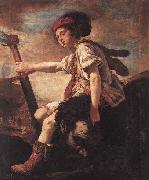
Öl auf dem Segeltuch,das echte Aroma von alten Meistern
|
FETI, Domenico
|
|||
|
|
|||

|
|||
David with the Head of Goliath
Gemälde IDENTIFIZIERUNG:: 63052 new21/FETI, Domenico-737227.jpg 1620 Oil on canvas, 153 x 125,1 cm Royal Collection, Windsor Feti was a peripatetic artist. Having been trained in Rome by the Florentine painter, Lodovico Cigoli, he worked at the court of Mantua from around 1613 and towards the end of his life spent some time in Venice. His principal patron was Duke Ferdinando Gonzaga at Mantua and it was with the purchase of the Gonzaga collection in 1625-27 that Charles I acquired a number of works by Feti. The artist was influenced by Venetian painters, as well as by Elsheimer and Rubens. His portraits and a series of small-scale pictures illustrating parables, probably commissioned by Ferdinando Gonzaga, are perhaps his best works. The artists technique is distinctive, with rapid brushstrokes of pure colour applied as highlights over broader areas of paint on canvases primed with dark tones. Similarly, the poses of his figures and the choice of viewpoints are often unusual. David with the Head of Goliath almost certainly formed part of the Gonzaga collection. A version of some quality is in Dresden (Staatliche Kunstsammlungen) and others are recorded. A date around 1620 has been suggested, that is, before the artist moved to Venice in 1622. The pose is somewhat reminiscent of the Ignudi by Michelangelo on the ceiling of the Sistine Chapel in Rome, and it is possible that the painting was meant to be hung as an overdoor. The present work depicts the story of David and Goliath as recounted in the first Book of Samuel, 17:48-51. The shepherd boy, David, defeats Goliath, the champion of the Philistines, in single combat using a sling with a stone. Afterwards David cuts off Goliath's head using the giants own sword. The body of Goliath is visible on the left in the middle distance. Feti cleverly contrasts the large scale of the decapitated head and sword with David's smaller body. Artist: FETI, Domenico Painting Title: David with the Head of Goliath , 1601-1650 Painting Style: Italian , , religious Siehe Galerie in Schweden |
|||
|
|
|||
|
|
|||
| Italian Baroque Era Painter, ca.1589-1624 | |||
| 1620 Oil on canvas, 153 x 125,1 cm Royal Collection, Windsor Feti was a peripatetic artist. Having been trained in Rome by the Florentine painter, Lodovico Cigoli, he worked at the court of Mantua from around 1613 and towards the end of his life spent some time in Venice. His principal patron was Duke Ferdinando Gonzaga at Mantua and it was with the purchase of the Gonzaga collection in 1625-27 that Charles I acquired a number of works by Feti. The artist was influenced by Venetian painters, as well as by Elsheimer and Rubens. His portraits and a series of small-scale pictures illustrating parables, probably commissioned by Ferdinando Gonzaga, are perhaps his best works. The artists technique is distinctive, with rapid brushstrokes of pure colour applied as highlights over broader areas of paint on canvases primed with dark tones. Similarly, the poses of his figures and the choice of viewpoints are often unusual. David with the Head of Goliath almost certainly formed part of the Gonzaga collection. A version of some quality is in Dresden (Staatliche Kunstsammlungen) and others are recorded. A date around 1620 has been suggested, that is, before the artist moved to Venice in 1622. The pose is somewhat reminiscent of the Ignudi by Michelangelo on the ceiling of the Sistine Chapel in Rome, and it is possible that the painting was meant to be hung as an overdoor. The present work depicts the story of David and Goliath as recounted in the first Book of Samuel, 17:48-51. The shepherd boy, David, defeats Goliath, the champion of the Philistines, in single combat using a sling with a stone. Afterwards David cuts off Goliath's head using the giants own sword. The body of Goliath is visible on the left in the middle distance. Feti cleverly contrasts the large scale of the decapitated head and sword with David's smaller body. Artist: FETI, Domenico Painting Title: David with the Head of Goliath , 1601-1650 Painting Style: Italian , , religious | |||
|
|
|||







